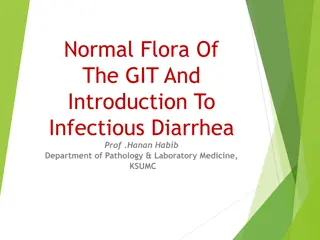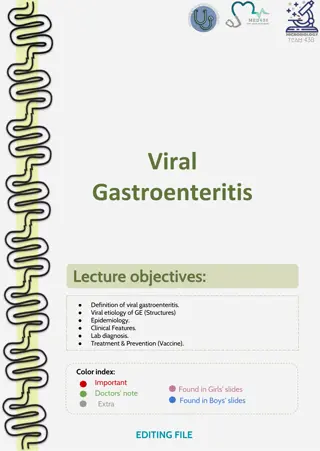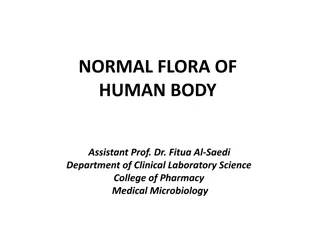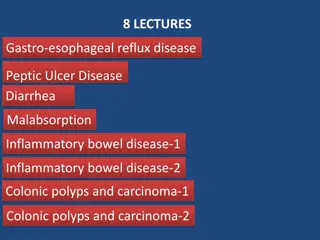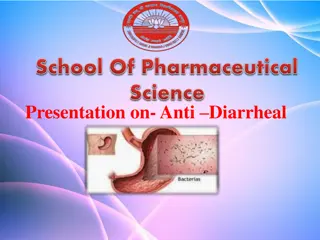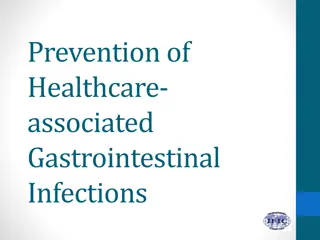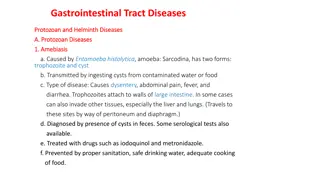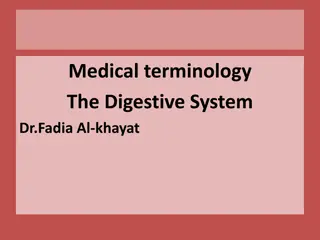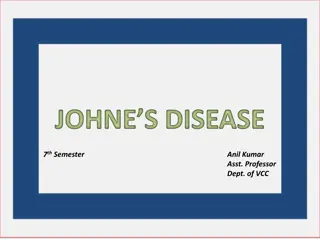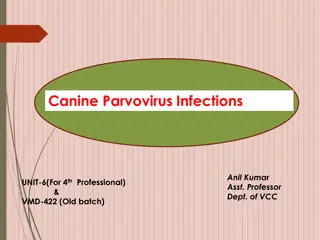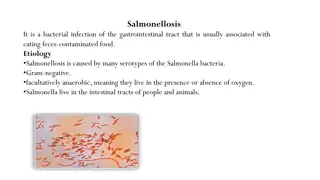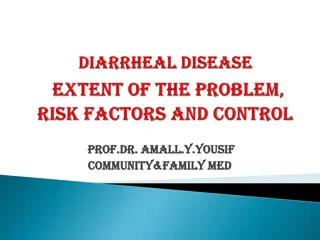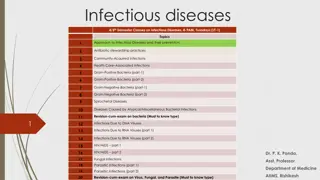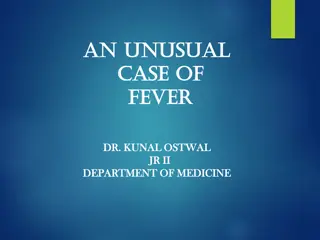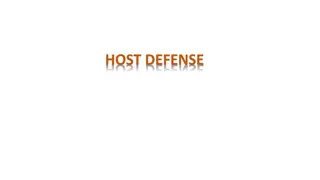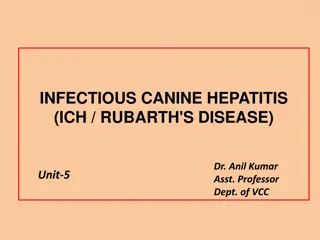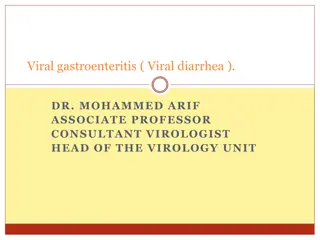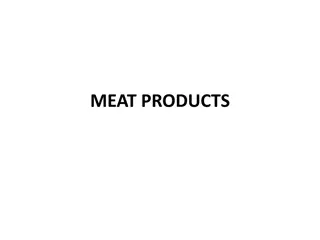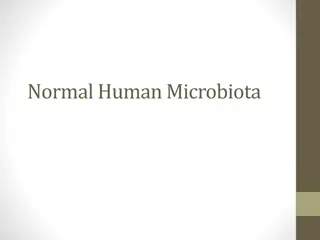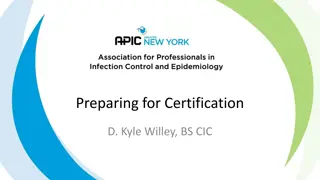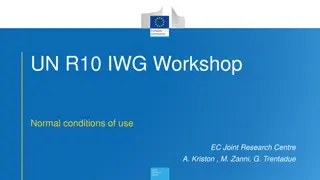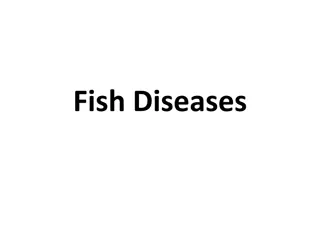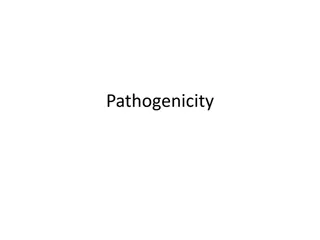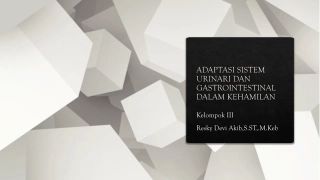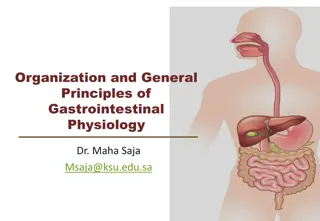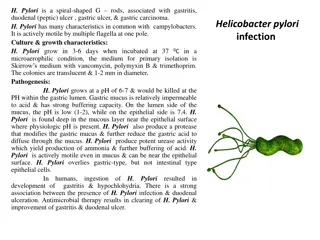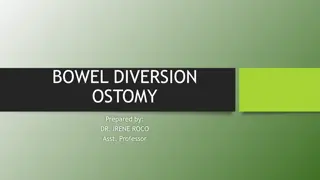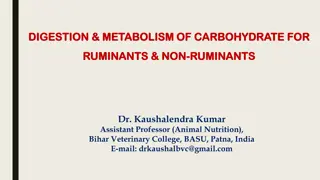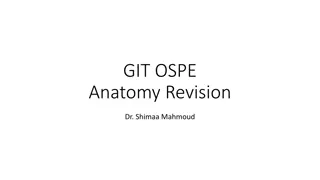Understanding Normal Flora of the Gastrointestinal Tract & Infectious Diarrhea
Normal flora in the gastrointestinal tract play a crucial role in maintaining health, but can also cause disease in certain conditions. This lecture covers the common flora in the GIT, their role in diseases, various types of acute diarrheal illnesses, epidemiology, and management of bacterial agents like Escherichia coli, Campylobacter, and Yersinia. It also discusses microbiological methods for diagnosis, pathogenesis, and prevention of food poisoning, travelers' diarrhea, and antibiotic-associated diarrhea.
Download Presentation

Please find below an Image/Link to download the presentation.
The content on the website is provided AS IS for your information and personal use only. It may not be sold, licensed, or shared on other websites without obtaining consent from the author. Download presentation by click this link. If you encounter any issues during the download, it is possible that the publisher has removed the file from their server.
E N D
Presentation Transcript
LECTURE: normal flora Of The GIT And Introduction To Infectious Diarrhea Editing File Important Doctor s notes Extra explanation Only F or only M " " .
OBJECTIVES: Know common normal flora of the GIT Understand the role of GIT normal flora in diseases Define and recognize the various types of acute diarrheal illness Describe the epidemiology the host defenses in preventing the gastrointestinal infection Explain pathogenesis by which Escherichia colicampylobacter and yersinia and their management Discuss the microbiological methods used for diagnosis of each of the bacterial agents including microscopy, selective media for maximal recovery Describe the pathogens, risk factors, clinical presentation and prevention of food poisoning travelers and antibiotic associated diarrhea. Name the etiological agents causing food poisoning and their clinical presentation
Introduction to normal flora: Introduction to normal flora: Normal flora are microorganisms that are frequently found in various body sites in normal healthy individuals Constituents and number vary according to the age and physiologic status Able to colonize and multiply under the exiting condition of different body sites. It has some advantages such as Inhibit competing intruders. ) Have symbiotic relationship that benefit the host ) Can cause disease in immunocompromised patients ( ( Normal flora - Gastrointestinal tract Normal Flora Of GIT Ecology Birth: sterile Breast-fed Bifidobacteria species Switch to cow s milk Enteric, bacteroides, enterococci, lactobacilli and clostridia Switch to solid food Microflora similar to parents Primarily anaerobic Facultative aerobes deplete oxygen Adult excretes 3x1013 bacteria/day Oral cavity: contain high number of flora which vary from site to site of the mouth. Saliva contain mixed flora :108 organism /ml Stomach : empty stomach* (sterile) has no normal flora in health due to HCL and peptic enzymes Small intestine : very scanty except near colon Colon of adults: 1010 org/gm stool, >90% are Bacteriodes ( the majority are anaerobic), 10% other bacteria (which are aerobic). Direct effect of diet composition. : -Ecology: the branch of biology dealing with the relations and interactions between organisms and their environment, including other organisms *But after eating food, it may contain some bacteria from ingested food.
Only in Males slides This table is from 435 team GI ecology Varies Location (adult)* Bacteria/gram Increase in the number contents Esophagus: Microbes associated with saliva and food Stomach: Low pH limits population numbers (10 bacteria/ml) 103-106 duodenum 105-108 jejunum and ileum Small intestine Proximal small intestine (duodenum and jejunum): Sparse (< 10^3 bacteria/ml fluid) due to acid from stomach, bile and pancreatic secretions Distal small intestine ( ileum): Increases ( 10^8 bacteria/ml) due to pH change In adult-bacteria per gram: Duodenum 10^3 -10^6 Jejunum and ileum 10^5 - 10^8 Large intestine 10^9-10^11/ml >350 species (E.coli = 0.1% of total population) In adult-bacteria per gram: Cecum and transverse colon 10^8 -10^10 sigmoid colon and rectum 10^11 cecum and transverse colon 108-1010 1011 sigmoid colon and rectum What you need to know is that the least number is at the stomach and increases until it reaches the peek in the large intestine *Explanation: the table includes the normal range of the normal flora population in different regions.
Only in females slides Normal flora (low virulence) Organ Mouth Nasopharynx Stomach Small intestine Colon of adults Colon of breast feding infants 1-Viridans streptococci 2- Neisseria spp Moraxella, Peptostreptococcus. Niesseriaspp., Viridanssterpt. Moraxella, Peptostreptoco ccus. streptococci, Peptosterptococ cus, others from mouth. scanty, variable Bacteriodes, Fusobacteriu m, Bifidobacteria, Lactobacillus, enterobacteria (is Aerobic),, Clostridium Bifidobacteriu m, Lactobacillus (are anaerobic) The Normal Flora Potential pathogen (carrier)* Organ Mouth Nasopharynx Stomach Small intestine Colon of adults Colon of breast feding infants Candida albicans S.pneumoniae, N.meningitidis, H.infuenzae,S.pyogenes, S.aureus none none B.fragilis, E.coli, Pseudomonas, Candida, Clostridium None This gives a hint about the advantages of breast feeding compare to bottle feeding The Normal Flora *But after eating food, it may contain some bacteria from ingested food.
Only in females slides Role of GIT normal Flora in disease -Many are opportunistic pathogens.they do not cause the disease unless if there is Example: perforation of the colon from ruptured diverticulum, feces enters into peritoneal cavity and cause peritonitis (may lead to septicemia) ) ( -Viridans streptocci of oral cavity enters the blood and colonize damaged heart valves. (such as endocarditis). ) ( ) ( -Mouth flora play a role in dental caries. -Compromised defense systems increase the opportunity for invasion. of this normal flora to cause serious disease ) ( -Death after lethal dose of radiation due to massive invasion of normal flora. -E.coli: the most common Enterobacteriacae; a facultative flora of colon followed by Klebsiella, Proteus and Enterobacter. -Salmonella, Shigella and Yersinia are NOT normal flora of the intestinal tract. -Some strains of E.coli,Salmonella ,Shigella and Yersinia enterocolitica are able to produce diseases in the intestinal tract.
Acute diarrheal illness and food poisoning: Introduction: Acute diarrheal illness is one of the most common problems evaluated by clinicians. A major cause of morbidity and mortality world wide. Most of healthy people have mild illness but other might develop serious squeals so it is important to identify those individuals who require early treatment. Definition of diarrhea: Stool weight in excess of 200 gm/day or 3 or more loose or watery stools/day Acute < 14 days Alteration in normal bowel movement characterized by decreased consistency and increased frequency Less than 14 days in duration Etiology: Viral the majority: 70-80% of infectious diarrhea (In children) in developed countries Bacterial: 10-20% of infectious diarrhea but responsible for most cases of severe diarrhea Protozoan: less than 10% (and may be complicated)
Epidemiology: 1.4 million deaths in study in 2010 1.2-1.9 episodes per person annually in the general population 2.4 episodes per child >3 years old annually 5 episodes per year for children <3 years old and in daycare Seasonal peak in the winter Risk Factors: 1. Food from restaurants. 2. Family member with Gastrointestinal symptoms. 3. Recent travel to developing countries. 4. Patient underlying illness and mediation( Stomach acidity cyst, spores) These patient more liable to get GIT disease 5. Abnormal peristalsis. 6. Low Immunoglobulin IgA. 7. Antibiotics decrease the normal flora to less 1012 8. Median infective dose (ID50) so if we have low ID50 , the Susceptibility will be high In countries that have disaster e.g. yemen they have more diarrheal diseases Mostly viral , usually if it is bacteria and the patient is not hospitalized campaylobacter is the organism and it is self limiting (the patients wont come to the hospital even.)
Classifications* 1. Infectious diarrhea: viral (Causes watery diarrhea) or Bacterial organism ( Campylobcator, Shigella,Solmonella,Yersinea, vibrio Cholera and E.coli). 2. Food poisoning: Staphylococcus aureus (their toxin is preformed thus their poisoning effect is quick (, Clostridium perfringens, Bacillus spp.) the incubation period of these 3 bcateria is Quick= 6 hours- half a day( 3. Traveler diarrhea: (can cause watery diarrhea) Enterotoxogenic (no invasion by the bacteria thus no pus ,and no fever because there is no inflammation) E-coli (incubation period 1-3 days and this is true for most of the diarrheal disease) 4. Antibiotic associated diarrhea: Clostridium difficile Intestinal pathogens: -Invasive and Cytotoxic strains produce inflammatory diarrhea ( Dysentry) with WBCs and /or blood in the stool. -Enterotoxin producing strains cause watery diarrhea with loss of fluid. -Some produce not only produce local infection in GIT systemic illness due to spread to multiple organs such as enteric ( typhoid) fever. Only in female s slides *The difference: Infectious Diarrhea : they eat infected food, Food poisoning : They have the bacteria and then produce the toxin inside the food.
Clinical Presentation and Pathogenic Mechanism 1-Enterotoxin mediated: Here the bacteria is dead but they already released their poison 2-Invasive: Here the bacteria are alive and the fight and release their poisons invasive mechanism large intestine is usually affected For enterotoxin mechanism small intestine is usually affected Sometime Solmonella spp, Campylobacter, some E-coli EHEC , Yersinia and Clostridium difficile Extension to lymph nodes Incubation period 1-3 days E.histolytica 1-3 wk Dysentery syndrome- gross blood and mucous with stool in small amounts after severe suprapubic pain , the pain is releaved after defection ends. ( ) EHEC bloody diarrhea If the cause is shigella we call it bacillus dysentery And if the cause is ameba histolytica we call amebic dysentery Lack of pus in the stool (no gut invasion) Lack of fever (because no inflammation) Rapid onset preformed toxin<12 hour Small intestine are affected Vomiting ,non-bloody diarrhea, abdominal cramp Vibrio cholerae, Staphylococcus aureus, Clostridium perfringens and Bacillus cereus All of these produce toxin which usually affect the small intestine and cause some abdominal cramp, nausea, vomiting and watery diarrhea, there is no invasion Other viral and some parasitic infection can produce toxin but more common is via bacteria. Pus and blood in the stool Fever due to inflammation Shigella, and Endameba histolytica (very important) Affect colonic mucosal surface of the bowel (the parasites have longer incubation periods than others).
Only in Males slides TOXIN TYPE TOXIN PRODUCING BACTERIA TOXIN NAME, IF RELEVANT Neurotoxin Food poisoning Staph aureus Enterotoxin B Bacillus cereus Emetic toxin Clostridium botulinum Botulinum toxin enterotoxin Vibrio cholerae Cholerae toxin Enterotoxigenic E.coli Heat-labile toxin, heat-stable toxin Clostridium perfringens Enterotoxin cytotoxin Shigella dysenteriae type I Shiga toxin Enterohemorrhagic E. coli Shiga toxins 1 and 2 Globotriaosylceramide (Gb3) 23 S r RNA in 60 Subunit Vibrio parahaemolyticus Thermostable direct hemolysin Campylobacter jejuni Cytolethal distending toxin Clostridium difficile Toxin A and B Clostridium perfringens -toxin E. histolytica Protozoal phospholipase A and pore-forming peptides
Only in Males slides A1-B5 protein enterotoxin that is exported out of the bacterial cell by a type II protein secretion system
Shigella, salmonella Shigella, salmonella salmonella shigella Salmonella enterica is the common cause of food poisoning in Saudi Arabia. It causes local Gastrointestinal invasion and bacteremia less common in normal host. Salmonella typhi transmitted through human faeces
Campylobacter Campylobacter Gram negative curved ( spiral or s-shape ) bacilli . world wide infection ,more common among children Common species : C.jejuni (the most common), C. coli, C fetus. Family Campylobacraceae -Genus arcobacter Epidemiology: Source: poultry, birds, dog , cat, water, milk, meat, person to person can occur IP: 2-6 days Lower abdominal pain , watery or dysenteric diarrhea with pus and blood. fever in some patients, bloody diarrhea, Nausea and vomiting are rare Self limiting 2-6 Day Chronic carrier outbreaks uncommon. Complications: May lead to autoimmune disease like Guillain- Barrie syndrome* (neurologic disease characterize by paralysis) and extra-intestinal infections eg. Reactive arthritis ,bacteremia ,lung infection and others frequently preceded by C.jejuni infection. Transport media Cary Blair Because it may die quickly if it does not transported to the lab Culture on CAMPY BAP media contain antibiotics Incubate in microaerophilic atmosphere (5%)O2 ,(10%)CO2 ,(85%)N at 42 C except C.fetus 37 C Identification: Gram stain/culture biochemical/Serology Only severe cases but usually is self limiting disease and no need for treatment. Ciprofloxacin, Erythromycin or Tetracycline Clinically Laboratory diagnosis treatment * The history is important, if we have patient who develop sudden paralysis after he had diarrhea we can think about Campylobacter, sure after excluding of other causes such as cardiovascular problems.
E. coli E. coli One of the most common normal flora, and not all of them can cause diarrhea, Only about 10 -15% of strains of E. coli associated with diarrhea, Other strains associated with extra-intestinal diseases( septicaemia, meningitis in neonates & UTI). Based on virulence factors, clinical manifestation, epidemiology and different O (lipopolysaccharides antigen) and H (flagella antigen) serotype. There are five major categories of diarrheagenic E.coli: E.Coli diarrhea Enterotoxigenic E.coli Enteropathogenic E.coli Enteroinvasive E.coli Enterohemorrhagic E.coli Enteroadherent* E.coli [ETEC] [EPEC] [EIEC] [EHEC] [EAEC] *also called enteroaggregative e coli
Enteroinvasive E.coli Enterotoxigenic E.coli The diseases Major cause of traveler's diarrhea in infant and adult in developing countries from contaminated food and water Produce dysentery (Penetration, invasion and distraction), Common in children High : 106-1010 106 Infective doses Symptoms watery diarrhea, abdominal cramps and some time vomiting Fever, severe abdominal cramps, malaise and watery diarrhea toxins Has heat-labile toxin (LT) and heat-stable toxin (ST) each has two fragment (A and B). No invasion or inflammation, LT leads to accumulation of CGMP, which lead to hyper secretion of fluid with no cellular injury - diagnosis No routine diagnostic method. Diagnosis Sereny* test and DNA probes. Other info Self limiting - -Similar to Shigella spp (Non motile, LNF) -transmition: Fecal oral route *They take the bacteria or its toxin and they are inoculated into the eye of an animal, after a period of time , we will see that there is destruction of an animal s eye. This indicate there is EIEC
Enterohemrrhagic E.coli ( very important) The most dangerous one and most common one The diseases O157H7 and Non O157H7 Hemorrhagic diarrhea, colitis and hemolytic uremic syndrome (HUS)= Platelet count, hemolytic anemia and kidney failure. Prevalence Fetal disease in young and elderly persons in nursing homes. symptoms Bloody diarrhea, low grade fever and stool has no leucocytes toxins Cytotoxin =vertoxin and vertoxin Similar to Stx1 (shigotoxin I&II). Diagnosis Diagnosis by culture on SMAC (sorbitol MacConkey agar cefixime), MUG test , Vertoxin detection by immunological test or PCR. Other info -Undercooked hamburgers it was known as hamburger s disease, unpasteurized dairy products, apple cider, cookie dough happen to help the bacteria. -E.coli other than 0157H7 can cause HUS.
Enteropathogenic E.coli Enteroadherent E.coli Enteroaggregative Ecoli The diseases Pediatric Diarrheal Disease. Causes Infantile diarrhea ( bottle fed infants) symptoms Produce mucoid, Watery diarrhea, vomiting, dehydration and abdominal pain. Low grade fever, malaise, vomiting and watery diarrhea Other info -produce Aggregative stacked bricked (like blocks), adherence to surface of intestinal epithelial cells. -resolve after 2 weeks or more -Outbreak in hospital nurseries and day-care centers -Stool mucous but no blood. -Disrupt microvilli and intestinal absorptive function.
Yersinia enterocolitica The diseases Mesenteric lymphadenitis in children and septicemia in immunocompramised hosts symptoms Presented with enteritis, arthritis and erythema nodosum Systemic manifestation not GIT only Prevalence Common in Europe, USA, Canada and cat, dog, swine (chitterlings) Characteristics Survive cold temperatures and associated with transfusion of packed red blood cells. Diagnosis Growth at 25 c-30 c media Cefsulodin-Igrasan-Novabiacin (CIN) Other info Generalize infection in adult and children 1-5 yrs usually mild but in old children adult mimic appendicitis In saudi arabia it can be misdiagnosed with appendicitis
Clostridium difficile The most common cause of Antibiotic associated diarrhea,( ampicillin, cephalosporins & clindamycin is the most common one). Antibiotic use for the last 8 weeks ( community acquired= outpatient) or hospital stay for at least 3 days ( hospital acquired=inpatient). So the duration is very important. The diseases Transmission Transmit from person to person via Fecal-Oral route. symptoms Patient Presents with fever, leukocytosis, abdominal pain and diarrhea toxins Produce toxin A ( enterotoxic & cytotoxic effects ) and B(cytotoxic which more serious) that can bind to surface epithelial cell receptors leading to inflammation mucosal injury and diarrhea Histological findings Pseudomembrane With endoscopy we can see it can result (neutrophils, fibrin, and cellular debris in the colonic mucosa) and toxic megacolon. Diagnosis* direct toxin detection from stool by (EIA) Treatment Metronidazole oral Vancomycin and supportive treatment. Other info -Have been cultured from in animate hospital surfaces. -causes Disruption of the indigenous bacterial flora of the colon *Once it is positive, we have two situations.. - If the patient has sever symptoms and with history of antibiotic in last 3 day this indicate Clostridium difficile infection - -if the patient is asymptotic and does not have a history of antibiotic this indicate that it is just colonies of this bacteria without infection.
Diagnostic approach Diagnostic approach Lab diagnosis of diarrheal diseases due to bacterial causes Lab diagnosis of diarrheal diseases due to bacterial causes Duration: Chronic vs acute Symptoms: Fever, bloody, weight loss and dehydration Risk factors: -Travel ,immunocompromised , diet, medications, outbreak -Fever and blood do culture -Watery no fever symptomatic treatment -Hospital acquire think about C.difficle Chronic diarrhea think about: -Protozoa (giardia, crypto, cyclo, microsporidia, MAC) -Other malabsorption, lactase deficiency Or bacterial overgrowth Stool specimen: Microscopy: for the presence of polymorphs or blood may help Culture : on selective media for Salmonella, Shigella & Campylobacter. (routinely in patient with diarrhea other bacteria if the doctor request them). Culture for Vibreo cholerae, EHEC or Yersinia if suspected. Toxin assay: if C.difficile toxins is suspected.
http://t2.gstatic.com/images?q=tbn:SdD2_7XPEywYzM:http://upload.wikimedia.org/wikipedia/commons/0/0f/Clostridium_difficile_01.pnghttp://t2.gstatic.com/images?q=tbn:SdD2_7XPEywYzM:http://upload.wikimedia.org/wikipedia/commons/0/0f/Clostridium_difficile_01.png 2. Enteroinvasive E.coli ( EIEC) E.coli Clostridium difficile http://t2.gstatic.com/images?q=tbn:CrQCk8qf1I0XNM:http://www.netterimages.com/images/vpv/000/000/013/13634-0550x0475.jpg http://t0.gstatic.com/images?q=tbn:pKOwzT7m-DDTuM:http://www.pathconsultddx.com/images/S155986750670818X/gr1-sml.jpg C.difficile & pseudomembraneous colitis Yersinia enterocolitica
Recommended Recommendedfrom prof from prof ali ali: : Type Organism Incubation Period 1-3 Days Source Risk factors Clinical Diagnosis Treatment Infectious diarrhea Shigella gram-negative rods Contaminated Food or water with human excreta Small amount of stool with blood and mucous and lower abdominal pain ( trismus) Culture on selective media Ciprofloxacin Invasive Dysentery Blood+mucous Entamoeba histolytica 1-3 wks Microscopy Metronidazole EIEC gram-negative rods 1-3 Days Culture and toxin detection Ciprofloxacin Type Organism Incubation Period Source Risk factors Clinical Diagnosis Treatment Food Poisoning Watery (preformed toxin) Staphylococcus aureus 1-6 hour Contaminated food from human flora Vomiting then watery diarrhea Culture and toxin detection Observation and supportive treatment Clostridium perfringens bacillus cereus spore forming aerobic Gram pos bacilli ETEC 8 to 16 hours Food contaminated with Soil 8 to 16 hours 8 to 16 hours Travelers 1-3 Days Travel Watery diarrhea Culture Toxin detection Toxin detection PCR ciprofloxacin Antibiotics Associated Clostridium 1-3 Days Antibiotics use patient patient Bloody diarrhea Toxin A and B Metronidazole +/- Vancomycin Difficile
Recommended Recommendedfrom prof Type from prof ali Organism ali: : Incubation Period 1-3 Days Source Risk factors S.typhi and S.para Human Others reptiles and snakes Clinical Diagnosis Treatment Infectious diarrhea Non-invasive Watery +/-blood Salmonella gram-negative rods Watery+/-Blood S.typhi and S.para typhi typhoid Others watery diarrhea Special media at 42 o C at microaerophilic condition Culture and toxin detection Ampicillin or ciprofluxaci or metronidazole or trimethoprim sulfa campylobacter jejuni small, curved, gram- negative rods 1-3 Days poultry Watery+/-Blood Erythromycin EHEC 1-3 Days beef Watery then bloody diarrhea Renal failure Rice water Vibrio cholera Comma-shape gram-negative rods Yersinia Gram Neg bacilli Listeria Monocytogenes Gram pos bacilli 1-3 Days Salt water Ciprofloxacin Doxycycline 1-3 Days Pork intestine Pseudo appendicitis Cold enrichment 25-30oC CIN (Yersinia) Gentamycin 2-3 wks unpasteurized dairy products Meningitis in neonate and old Abortion Ampicillin
QUIZ: Q1-which one of the following species of E.coli causes traveler s diarrhea? A-ETEC B-EPEC C-EHEC Q2-the best drug used to treat clostridium difficile is? A-ampicillin B-metronidazole C-erythromycin Q3-A 24 year old patient presented with dysentery stool. The lab results showed gram ve bacilli. Which one of the following is the causative organism? A-EPEC B-EIEC C- EHEC Answers: 1-A 2-B 3-B
THANK YOU FOR CHECKING OUR WORK, BEST OF LUCK! Hamad Alkhudairy Ibraheem Aldeeri Basel almeflh Shrooq Alsomali Weam Babaier Rawan Alqahtani Doctors slides


